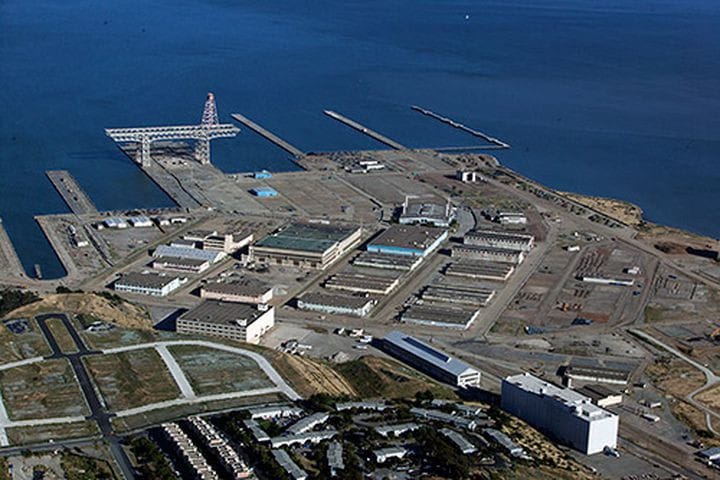by Ahimsa Porter Sumchai, MD
Like denying a paternity suit when the baby looks just like you, US Navy BRAC Environmental Coordinator Derek J. Robinson issued a statement published by the San Francisco Public Press in an article authored by award winning investigative journalist Chris Roberts, “Toxic Metals Found in Shipyard Neighbors”:
“The Navy conducts its ongoing clean-up efforts while simultaneously ensuring continued public safety … High levels of toxic elements could be explained by medical history, diet, immune status, genetics and hobbies, where they live, their occupation, place of work and other environmental factors.”
Robinson’s denial of the findings of shipyard soil elements in toxic concentrations in 30 residents and workers within a one-mile radius of the federal Superfund site is like denying a paternity suit … when the DNA test is a match! All chemicals detected to date – using a simple urine toxicology test analyzed by mass spectrometry – are documented by the Navy’s Parcel A Record of Decision to be present in Parcel A soils or by the Nuclear Regulatory Commission (NRC) as having been used by scientists of the Naval Radiological Defense Laboratories (NRDL) at the Hunters Point Naval Shipyard.
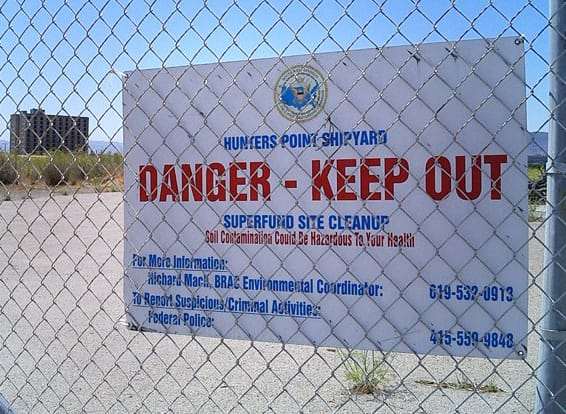
On July 28, 2019, I authored an article published in the SF Bay View newspaper, challenging the myth of low level radiation. It referenced the findings of a physician scientist I hold in high esteem. Founder of the Nobel Prize winning International Physicians for the Prevention of Nuclear War, Stanford and Harvard Professor Emeritus Herbert Abrams discovered low dose exposure to x-rays and gamma rays increases your risk of cancer.
Abrams sat on a committee of 16 international experts to develop risk estimates in a series of reports issued in the aftermath of the July 1945 atomic bombing of Hiroshima and Nagasaki. Biological Effects of Ionizing Radiation (BEIR VII) reviewed new data on atomic bomb survivors, their offspring and 1,300 research studies on radiation exposure at the cellular level.
The Hunters Point Community Biomonitoring Program launched in January 2019 driven by the urgent need to offer human testing for neighbors and workers at the federal Superfund site following the crisis that emerged in 2018 in the aftermath of efforts to minimize and delay discovery of a radium emitting device in a newly developed residential neighborhood at the shipyard. Radium 226 is one of the most abundant gamma emitters in shipyard soils. Its adverse health effects are illustrated best by Nobel winner Madame Marie Curie who discovered radium and died from leukemia.
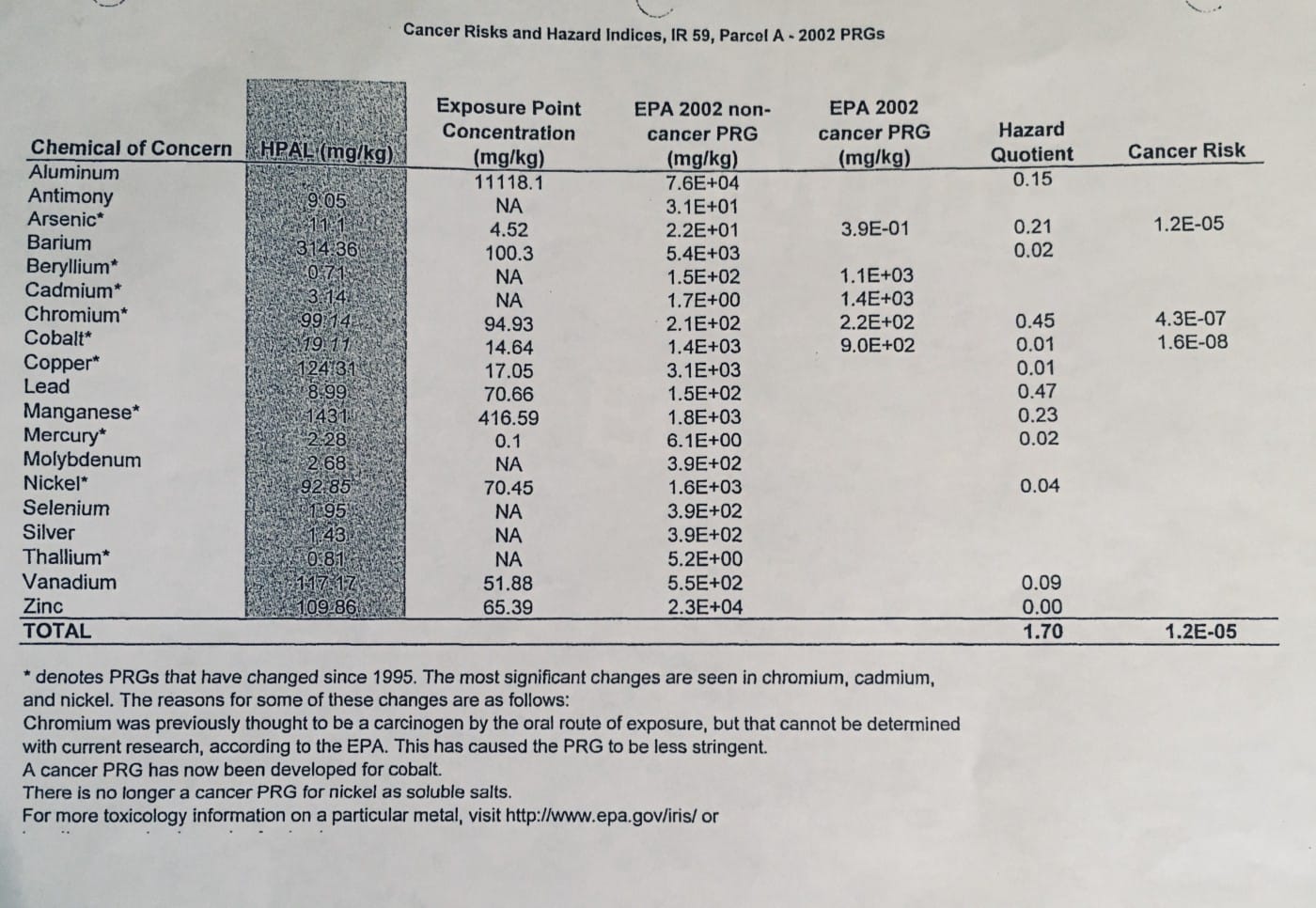
The Hunters Point Community Biomonitoring Program conducted urinary toxicological screenings in residents and workers with medical histories of cancer and tumors. In all cases, chemicals were detected in elevated concentrations proven to be present in shipyard soils and to be carcinogenic, immune suppressing and tumor inducing. Three cases prove this point:
“Mr. T” has lived and worked adjacent to the shipyard for decades. He is a “big man” who works overnights as a heavy equipment operator at a major industry on Pier 96. “Mr. T” does not smoke or drink, attends church and has never failed a mandatory drug test. He is exposed to toxic metals and sees dust at work, in his home and surrounding environment. Seasonal allergies and constant exposure to particle pollution make his eyes red, his nose stuffy, trigger asthma attacks and acid reflux. Once he had an asthma attack after inhaling toxic dust in his workplace so severe he could not breath. His supervisor said, “You’re just coughing – go back to work!”
“Mr. T” went to an urgent care clinic instead, where he was treated immediately with mist inhalers for severe occupational asthma. Fortunately for “Mr. T,” that episode of asthma triggered at work was in his medical record when he was diagnosed with throat cancer in 2018. It supported his claim the throat cancer was caused by exposure to inhaled toxins in his workplace. His employer contested the claim.
Had “Mr. T” been exposed to toxic dust while operating a tractor during cleanup of New York’s pulverized Twin Towers on 9/11, he would easily qualify for entry into the World Trade Center Health Program with verified medical conditions like chronic sinusitis, asthma, acid reflux and throat cancer. He would be eligible for health and financial benefits and his offspring would be eligible for survivor benefits. Additionally, he and his family would be part of a surveillance system designed to detect generational health effects from his documented exposure.
But instead, “Mr. T” faced disability and financial loss, catastrophic weight loss, life threatening complications from radiation and chemotherapy – and an employer who denied his claim a lethal throat cancer was caused by workplace toxic exposures.
“Mr. T” requested biomonitoring evaluation and urinary screening in 2019. The first urine test detected numerous chemicals in toxic concentrations including aluminum, bismuth and the radioactive element gallium. All elements detected in elevated concentrations are documented to have been used at the shipyard including the alpha emitter Bismuth-207 that was used by NRDL.
Kathyrn Higley is the Navy’s paid radiation expert. Higley responded to the urine screening results released by “Mr. T” and expressed her opinion that gallium – detected in concentrations almost two times higher than maximum – might be a “false positive” caused by residual gallium in “Mr. T’s” body from contrast agents used in MRI scans to image his throat cancer a year earlier.
Additionally, a toxicology consultant suggested “Mr. T’s” elevations in aluminum and bismuth might be due to antacids taken for acid reflux. Recognizing the validity of these concerns, HP Biomonitoring conducted an advanced records review and repeat urine screening to determine whether aluminum and bismuth concentrations were declining and if gallium concentrations had been transiently elevated due to medical use in contrast agents. The repeat urine screening revealed the following:
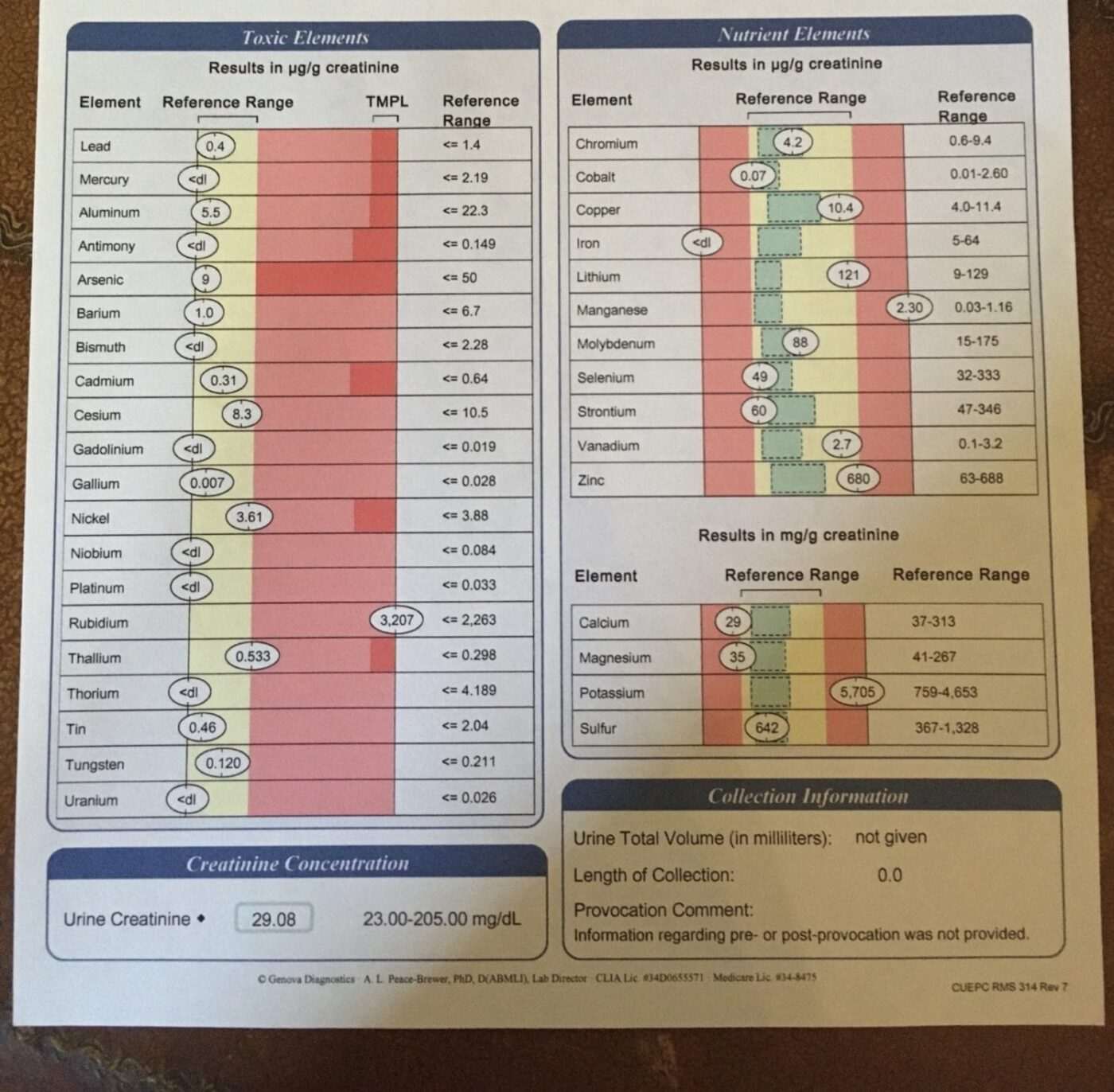
Findings on repeat urine toxicology screen support the opinion that gallium detected in the original screening may have been elevated due to the “false positive” detection of residual gallium from contrast agents used to image cancers of the throat. Detecting gallium in toxic concentrations due to contrast agents administered a year earlier is not, however, consistent with its basic pharmacokinetics. Over 90 percent of a gallium dose administered in contrast agents is excreted within 24 hours.
HP Biomonitoring investigators concede elevations in aluminum and bismuth concentrations on the initial urine screening test could have been due to use of antacids but conclude occupational exposure cannot be excluded. “Mr. T” works in a recycling plant, perpetually exposed to aluminum scrap, volatilized metals and visible dust. It is equally likely aluminum, tin, bismuth and even gallium levels detected in toxic concentrations on the initial urine screening returned to normal during the period in which he was disabled by throat cancer and not working.
Manganese was detected on repeat urine screening well above reference range in “Mr. T” and in all HP Biomonitoring urinary screenings performed to date consistent with a community wide exposure from a community wide source of toxic release: the Hunters Point Naval Shipyard – a federal Superfund site.
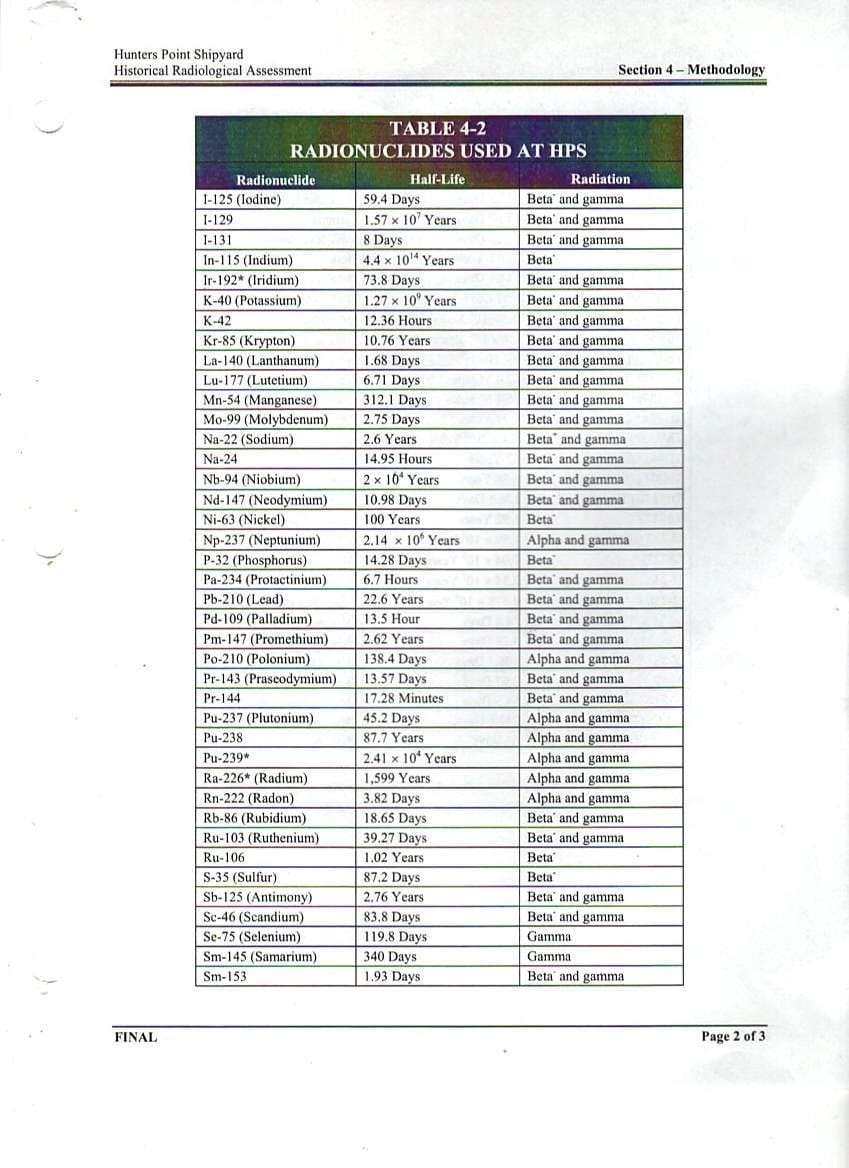
Manganese is a nutrient element that, in normal concentrations, plays a vital role in human physiology. It is one of the iron group of elements present in stars and disseminated by supernova explosions. Manganese is a natural component of the serpentinite bedrock of the Hunters Point hilltop that was graded beginning in 2005 releasing tons of asbestos and toxic mineral particulates. Manganese exists as a stable element and has 18 gamma emitting radioisotopes. In toxic concentrations, it impairs the immune system and blocks dopamine causing mood instability and impulsivity. In the first ecological study of its kind, North Carolina researcher John Spangler, MD, found groundwater and airborne manganese correlated with cancer mortality at the county level.
“Dr. B” is a high level administrator for the San Francisco Unified School District. She is an attractive high functioning professional woman who broke racial barriers as a flight attendant for an international airline prior to earning a PhD. Dr. B inherited her mother’s home near the shipyard’s South Basin region. Prior to that she lived in a newly constructed housing development on the Hunters Point hilltop west of the shipyard where she recalls being bombarded by dust particles that triggered chronic sinusitis and asthma.
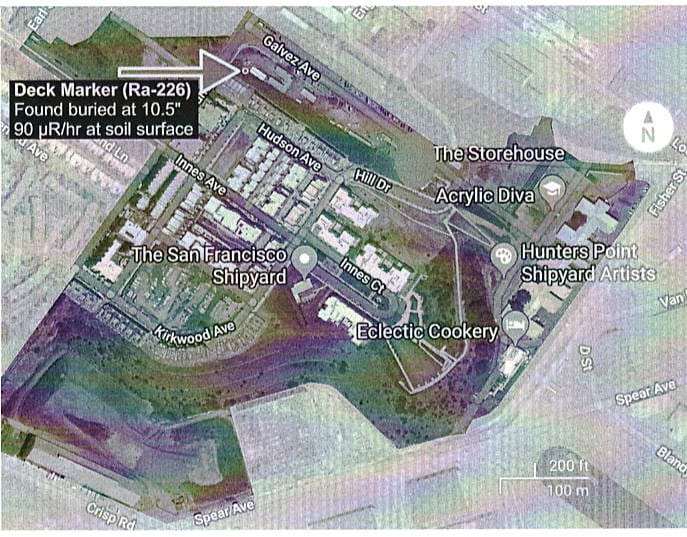
“Dr. B” underwent surgery at UCSF for tumors of the brain and lung diagnosed simultaneously while living on the Hunters Point hilltop. She presented to HP Biomonitoring in January of 2020 after being diagnosed with brain tumors compressing the auditory nerves in both ears. “Dr. B” recalls an ENT surgeon once asked if she “lived near a toxic dump.” Her biomonitoring evaluation mapped the location of her home less than a mile from the South Basin – the toilet of the Hunters Point Naval Shipyard!
“Dr. B” has arsenic concentrations in her urine that exceed Tentative Maximum Permissible Levels (TMPL) along with gadolinium in concentrations 20 times greater than allowable. Gadolinium is “highly toxic” as a free agent according to Wikipedia. It was used at the shipyard for neutron shielding in nuclear reactors and nuclear propulsion systems and has been detected in toxic concentrations in multiple HP Biomonitoring urine screenings. Gadolinium is used in contrast agents for breast MRI screenings of high risk women. Concerns about its safety are ongoing given its ability to remain in the brain and body for years.
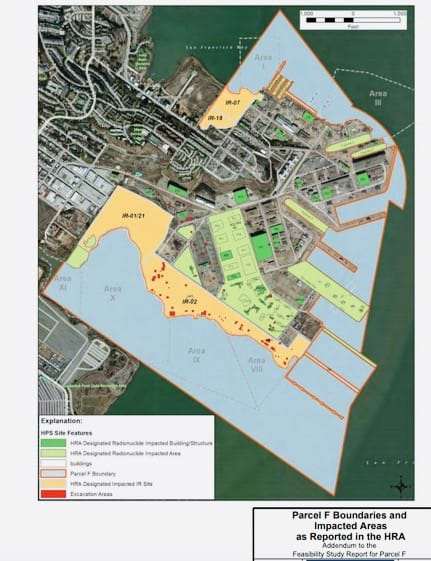
“Ms. L” has lived for 33 years in a home she owns on Oakdale Avenue a quarter of a mile from the Hunters Point Naval Shipyard. She is an artist and activist who worked for ten years as a platemaker for the San Francisco Chronicle newspaper at the Evans Avenue print shop. The street where she lives and walks her dog, runs one block parallel to the Hunters Point Naval Shipyards historic entry east from 3rd and Palou onto Crisp Road-where the United States Naval Radiological Defense Laboratories (NRDL) operated in the 800 series buildings from 1946 to 1989.
“Ms. L” served as an elected member of the Hunters Point Shipyard Restoration Advisory Board (RAB) from 2000 until the Navy dissolved the body in 2009. While serving on the RAB and living within a “stone’s throw” from the shipyard’s radiation contaminated shorelines and laboratories, “Ms. L” underwent two brain surgeries to remove tumors at the base of her skull and beneath the frontal lobes of her brain and a lumpectomy to excise breast cancer. She has been told there are additional small tumors in her brain. She requested voluntary biomonitoring evaluation and urinary screening in 2020 to determine why she has been diagnosed with so many cancerous and noncancerous tumors.
The United States Department of the Navy operates at the former Hunters Point Naval Shipyard under the auspices of the Southwest Division of Naval Facilities Engineering Command located in San Diego. Derek J Robinson is the BRAC Environmental Coordinator for remediation activities at the federal Superfund site. The U.S. Navy is the principal generator of toxic emissions and discharges on the base. Many discharges and releases are actions performed under the guidelines of the CERCLA act – many are not!
My final year on the Hunters Point Naval Shipyard Restoration Advisory Board was 2005. It was the year I voiced public opposition to the Navy’s adoption of Time Critical Removal Actions, called TICRAs. TICRAs are remedial actions performed outside the nine-step process required by federal Superfund law with the intent of expediting cleanups that pose imminent threats to human health and the environment. TICRAs offer corrupt development interests an opportunity to fast track residential development at one of the most contaminated properties on the National Priorities List.

The Tetra Tech soil scandal has mushroomed into a public health crisis with the finding of heavy metals and radioactive elements in the bodies of workers and neighbors nearby. In 2005 Tetra Tech was awarded a contract by the U.S. Navy to perform TICRAs throughout the base. That’s how the Tetra Tech soil fraud began – when the Navy granted Tetra Tech license to “run amok” outside the federal Superfund act and conduct radiological soil and building cleanups with restricted regulatory oversight.
In response to HP Biomonitoring’s detection of dozens of toxic chemicals in the urine of Hunters Point residents and workers using the validated analytic method mass spectrometry and the new science of biomonitoring, Navy BRAC Environmental Coordinator Derek J. Robinson denied an expanding archive of evidence based documentation proving the shipyard’s original EPA Hazard Ranking Score of 80 percent accurately predicted it is not safe for residential development!
The buck stops with the U.S. Navy at the Hunters Point Naval Shipyard! The Navy is ultimately responsible in civil and criminal actions seeking damages for negligence in shipyard remediation and oversight, discharging toxic landfill gases into the air, and the 2004 decision to relax cleanup standards for manganese – a chemical detected in toxic concentrations in 100 percent of HP Biomonitoring urine screenings to date.
It is my hope the Polluter Pays Principle will be applied nationwide to toxic exposures we can now fingerprint as having emanated from remediation and development activities on a federal Superfund site. It is my dream we will one day see the establishment of the Hunters Point Community Toxic Registry, modeled after toxic registries operating nationally at the Veterans Administration hospitals and the World Trade Center Health Program.

The U.S. Navy at Hunters Point denies toxic chemicals – documented by the Navy to be present in soil and landfills at a fraudulently cleaned Superfund site – are being detected in shipyard neighbors using state of art biotechnology, personalized medicine and the new science of human biomonitoring.
“Tis the business of little minds to shrink, but they whose heart is firm, and whose conscience approves their conduct, will pursue their principles unto death.” – Leonardo da Vinci
References:
Soundcloud https://youtu.be/_reLNgO5KEs
The Struggle for Justice at SF Hunters Point Naval Shipyard & Dr. Ahimsa Porter Sumchai https://youtu.be/ZMm51Cm_Nao
https://sfbayview.com/2020/04/perfect-storm-first-wave-of- the-covid-19-pandemic-crashes-in-southeast-san-francisco/
Hunters Point Shipyard Historical Radiological Assessment Volume 2 1939–2003 https://www.nrc.gov/docs/ML0425?ML042580203.pdf
SF Bay View Health and Environmental Science Editor Ahimsa Porter Sumchai MD, medical director of the Hunters Point Community Biomonitoring Program, founding chair of the Hunters Point Naval Shipyard Restoration Advisory Board’s Radiological Subcommittee and contributor to the 2005 Draft Historical Radiological Assessment, can be reached at asumchai@gmail.com. Dr. Sumchai is also president and medical director of Golden State MD Health & Wellness, an author and a UCSF and Stanford trained researcher.





